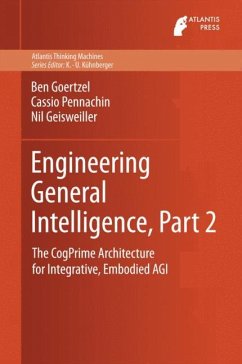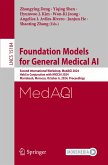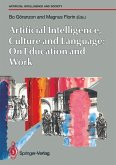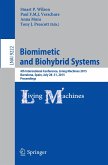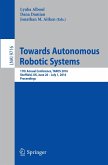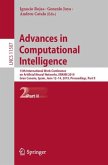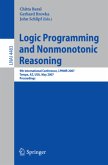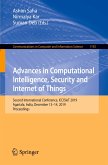Ben Goertzel, Cassio Pennachin, Nil Geisweiller
Engineering General Intelligence, Part 2
The CogPrime Architecture for Integrative, Embodied AGI
Ben Goertzel, Cassio Pennachin, Nil Geisweiller
Engineering General Intelligence, Part 2
The CogPrime Architecture for Integrative, Embodied AGI
- Gebundenes Buch
- Merkliste
- Auf die Merkliste
- Bewerten Bewerten
- Teilen
- Produkt teilen
- Produkterinnerung
- Produkterinnerung
The work outlines a detailed blueprint for the creation of an Artificial General Intelligence system with capability at the human level and ultimately beyond, according to the Cog Prime AGI design and the Open Cog software architecture.
Andere Kunden interessierten sich auch für
![Foundation Models for General Medical AI Foundation Models for General Medical AI]() Foundation Models for General Medical AI39,99 €
Foundation Models for General Medical AI39,99 €![Artifical Intelligence, Culture and Language: On Education and Work Artifical Intelligence, Culture and Language: On Education and Work]() Artifical Intelligence, Culture and Language: On Education and Work41,99 €
Artifical Intelligence, Culture and Language: On Education and Work41,99 €![Biomimetic and Biohybrid Systems Biomimetic and Biohybrid Systems]() Biomimetic and Biohybrid Systems39,99 €
Biomimetic and Biohybrid Systems39,99 €![Towards Autonomous Robotic Systems Towards Autonomous Robotic Systems]() Towards Autonomous Robotic Systems39,99 €
Towards Autonomous Robotic Systems39,99 €![Advances in Computational Intelligence Advances in Computational Intelligence]() Advances in Computational Intelligence79,99 €
Advances in Computational Intelligence79,99 €![Logic Programming and Nonmonotonic Reasoning Logic Programming and Nonmonotonic Reasoning]() Chitta Baral / Gerhard Brewka / John Schlipf (eds.)Logic Programming and Nonmonotonic Reasoning39,99 €
Chitta Baral / Gerhard Brewka / John Schlipf (eds.)Logic Programming and Nonmonotonic Reasoning39,99 €![Advances in Computational Intelligence, Security and Internet of Things Advances in Computational Intelligence, Security and Internet of Things]() Advances in Computational Intelligence, Security and Internet of Things39,99 €
Advances in Computational Intelligence, Security and Internet of Things39,99 €-
-
-
The work outlines a detailed blueprint for the creation of an Artificial General Intelligence system with capability at the human level and ultimately beyond, according to the Cog Prime AGI design and the Open Cog software architecture.
Produktdetails
- Produktdetails
- Atlantis Thinking Machines 6
- Verlag: Atlantis Press / Springer, Berlin
- Artikelnr. des Verlages: 978-94-6239-029-4
- 2014
- Seitenzahl: 584
- Erscheinungstermin: 14. März 2014
- Englisch
- Abmessung: 241mm x 160mm x 37mm
- Gewicht: 977g
- ISBN-13: 9789462390294
- ISBN-10: 9462390290
- Artikelnr.: 39392238
- Herstellerkennzeichnung Die Herstellerinformationen sind derzeit nicht verfügbar.
- Atlantis Thinking Machines 6
- Verlag: Atlantis Press / Springer, Berlin
- Artikelnr. des Verlages: 978-94-6239-029-4
- 2014
- Seitenzahl: 584
- Erscheinungstermin: 14. März 2014
- Englisch
- Abmessung: 241mm x 160mm x 37mm
- Gewicht: 977g
- ISBN-13: 9789462390294
- ISBN-10: 9462390290
- Artikelnr.: 39392238
- Herstellerkennzeichnung Die Herstellerinformationen sind derzeit nicht verfügbar.
The Open Cog Framework.- Knowledge Representation Using the Atomspace.- Representing Procedural Knowledge.- Emotion, Motivation, Attention and Control.- Attention Allocation.- Economic Goal and Action Selection.- Integrative Procedure Evaluation.- Perceptual and Motor Hierarchies.- Integrating Cog Prime with a Compositional Spatiotemporal Deep Learning Network.- Making DeSTIN Representationally Transparent.- Bridging the Symbolic/Subsymbolic Gap.- Procedure Learning as Program Learning.- Learning Procedures via Imitation, Reinforcement and Correction.- Procedure Learning via Adaptively Biased Hillclimbing.- Probabilistic Evolutionary Procedure Learning.- Probabilistic Logic Networks.- Spatio-Temporal Inference.- Adaptive, Integrative Inference Control.- Pattern Mining..- Speculative Concept Formation.- Dimensional Embedding.- Mental Simulation and Episodic Memory.- Integrative Procedure Learning.- Map Formation.- Communication Between Artificial Minds.- Natural Language Comprehension.- Language Learning via Unsupervised Corpus Analysis.- Natural Language Generation.- Embodied Language Processing.- Natural Language Dialogue.- Summary of Argument for the Cog Prime Approach.
The Open Cog Framework.- Knowledge Representation Using the Atomspace.- Representing Procedural Knowledge.- Emotion, Motivation, Attention and Control.- Attention Allocation.- Economic Goal and Action Selection.- Integrative Procedure Evaluation.- Perceptual and Motor Hierarchies.- Integrating Cog Prime with a Compositional Spatiotemporal Deep Learning Network.- Making DeSTIN Representationally Transparent.- Bridging the Symbolic/Subsymbolic Gap.- Procedure Learning as Program Learning.- Learning Procedures via Imitation, Reinforcement and Correction.- Procedure Learning via Adaptively Biased Hillclimbing.- Probabilistic Evolutionary Procedure Learning.- Probabilistic Logic Networks.- Spatio-Temporal Inference.- Adaptive, Integrative Inference Control.- Pattern Mining..- Speculative Concept Formation.- Dimensional Embedding.- Mental Simulation and Episodic Memory.- Integrative Procedure Learning.- Map Formation.- Communication Between Artificial Minds.- Natural Language Comprehension.- Language Learning via Unsupervised Corpus Analysis.- Natural Language Generation.- Embodied Language Processing.- Natural Language Dialogue.- Summary of Argument for the Cog Prime Approach.

